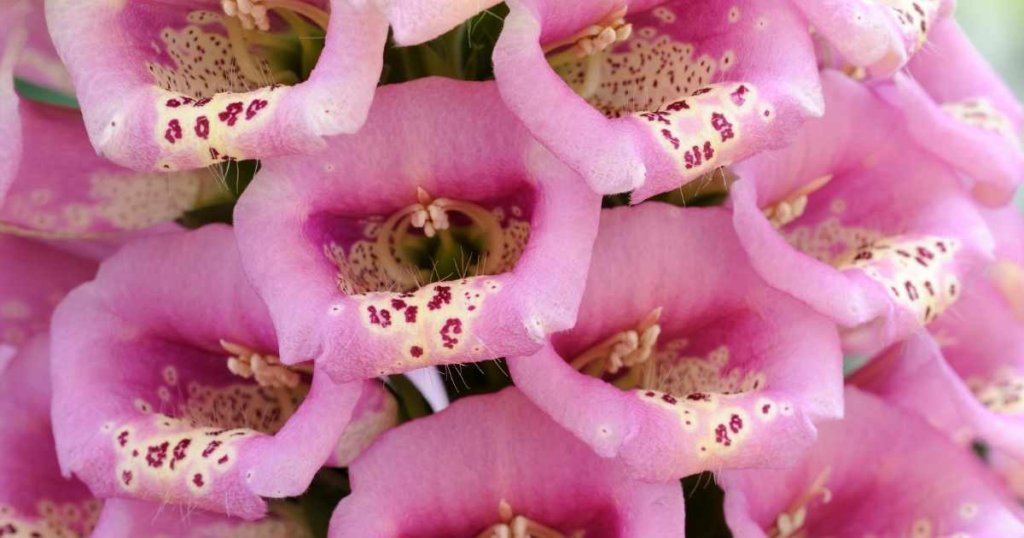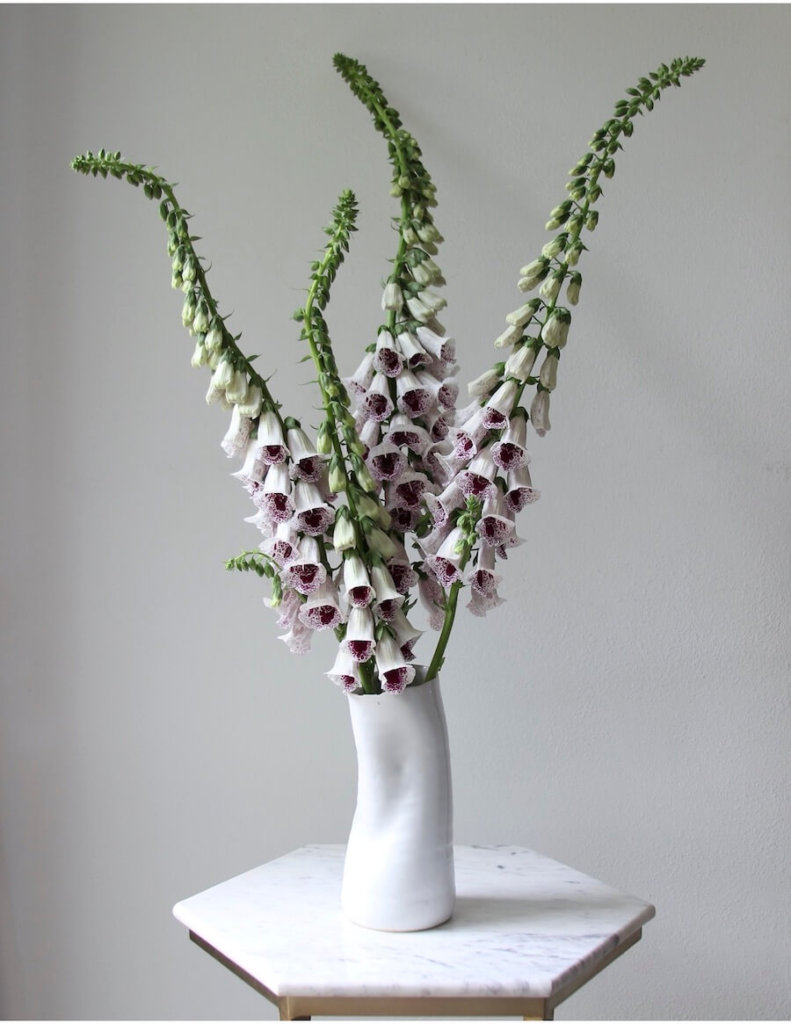
No cottage flower garden is complete without the beauty and elegance of foxgloves. But is it possible to grow foxglove successfully in our brutal North Texas heat?
Good news: yes, it is. Once you understand what foxgloves need and how to troubleshoot common problems, you’ll be able to recreate the quintessential English cutting garden in your own backyard.
What You Need To Know About Growing Foxglove in North Texas
- What You Need To Know About Growing Foxglove in North Texas
- Starting Foxgloves From Seed
- Buying Transplants
- Where To Plant Foxglove
- What They Need To Thrive in North Texas
- Do Foxgloves Need Support?
- Harvesting Foxglove Flowers
- How To Encourage Foxgloves To Come Back Every Year
- Foxglove Varieties
- Foxglove Warning
- Where to buy seeds
- Summary
What is foxglove anyway?
Foxglove is the common name of the Digitalis plant genus. Digitalis can be found growing wild in Europe, but is cultivated worldwide as an ornamental flower. With bloom stalks that can reach up to five feet tall, foxgloves are dramatic in the landscape and make excellent
Before you can grow foxglove in your own garden, it’s important to understand how foxgloves work.
Foxgloves are biennial flowers. This means that they put on vegetative growth during the first year, bloom during the second year, and then die. Thanks to advances in breeding technology, however, there are new series of foxglove plants like Dalmatian, Foxy, and Camelot that bloom in the first year.
If you are starting foxglove from seed, make sure that you know whether they are first year or second year bloomers. That way, you will know when to expect blooms.

A Cold Hardy Annual
Another important thing to know about foxgloves is that they are cold-hardy annuals. These are annual (or biennial, in this case) plants and flowers that are planted in the fall, overwintered, and then bloom the following spring or the spring after that.
The benefit of growing cold-hardy annuals in North Texas is that they spend the winter developing large, strong root systems, and then put on a great show of blooms in the spring.
Alternatively, you can plant these annuals and biennials in early spring, but that doesn’t give the plants much time to grow before hot summer weather arrives.
Starting Foxgloves From Seed
To grow foxgloves from seed here in North Texas, start the foxglove seeds indoors in August. (I start mine around August 15th). This gives the plants 6-8 weeks to mature before planting out in the garden.
In general, most cold-hardy annuals need to be planted outdoors 6-8 weeks before the last frost date and started by seed 6-8 weeks before transplant date. Here in the DFW area, the average first frost date is November 21. This means that the ideal foxglove seed-starting window is July 21 – August 21.
As I teach my students in the Indoor Seed-Starting class, the number one thing to do when starting seeds indoors in the summer is to watch the temperature. In winter, you can easily start seeds in a garage, but it’s too hot during the summer for that.
Try to start seeds somewhere inside your house where temperatures can stay around 70-75 degrees. Otherwise, high heat can cause seedings to get weak and leggy.
Once your foxglove seedlings are large enough, transplant them into the garden in October.
Buying Transplants
Foxglove transplants are typically available for purchase from local nurseries in early spring. Purchasing transplants this way is instantly gratifying, but it can be problematic.
If you purchase a variety in bloom and it is a second-year bloomer, then the plant will start the process of dying after flowering unless there is enough seed dropped for plants to grow back. Another problem is that spring-planted transplants don’t have much time to establish deep roots until summer heat arrives.
The solution is to buy and plant transplants in the fall, but it is rare to see them in nurseries at this time.
Luckily, online retailers offer bare-root foxglove transplants available for shipping in the fall. Bluestone Perennials is a respected online retailer that provides this service.

Where To Plant Foxglove
Foxgloves are a wonderful addition to existing perennial beds. They can also be grown in raised beds if you are growing them as
Sunlight Requirements
My foxglove patch is located in an area that gets unobstructed sun from sunrise to sunset. Though I’ve been successful with this location, it’s not ideal. Foxgloves would rather be planted in an area that gets some shade in the afternoon. Locations like this are known as “partial shade”. If planting in full sun, be prepared for the foxgloves to struggle a bit in midsummer.
Preparing The Location
If you have poorly draining soils due to a heavy clay content, amend your garden bed with plenty of high-quality compost and expanded shale before planting. (I recommend one bag of compost and one bag of expanded shale for every four square feet mixed into the soil to a depth of 6-8 inches.) The compost will provide sufficient nutrition during fall and winter growth.

What They Need To Thrive in North Texas
Foxglove plants have average water and nutrient needs. During the first year of growth, water your foxgloves as you would any other perennial in your garden.
Though foxgloves are not heavy feeders, it’s a good idea to give them an application of organic
Common Problems
In mid-summer, my foxgloves start showing signs of disease: yellowing leaves, spotting, and eventually death of lower leaves. I treat the problem successfully with an application of
In order to prevent disease issues with your foxgloves, be sure to give each plant plenty of space. Allow for 12″ between each plant at the minimum, but a 24″ spacing would be ideal.

Do Foxgloves Need Support?
Different varieties of foxgloves will grow to different heights. If you are growing foxgloves for
Harvesting Foxglove Flowers
Though bloom time varies by variety, here in North Texas foxgloves start blooming in mid-April and continue through early May. To use foxglove for
To get the longest vase life possible, be sure to use a
Even if you are not using foxgloves as

How To Encourage Foxgloves To Come Back Every Year
Many people assume that foxgloves are perennial plants because in many gardens they will come back to bloom year after year. There are few things that you can do to encourage foxglove to behave as a perennial and come back every year:
- Deadhead foxglove plants frequently when they are blooming. This does two things: it encourages side shoots to form, and it prevents the plant from going to seed. Some suggest that preventing seed formation will encourage perennial behavior.
- Let a few blooms go to seed so that the seed will drop and form new plantlets.
- Divide foxgloves frequently. After spring flowering or in the fall, lift the plants and separate the new basal rosettes. Plant in another area. If existing foxglove plants are becoming too crowded, lift and replant with more space. Additional spacing will help to reduce disease pressure and encourage larger individual plants and bloom stalks.

Foxglove Varieties
‘Pam’s Choice’
Pam’s Choice is a dramatic foxglove that can reach up to five feet tall when allowed to bloom fully in the garden. White flowers with speckled, deep plum-colored throats. Second-year blooming.
‘Sugar Plum’
Sugar Plum reaches three to four feet tall and boasts a gorgeous deep pink coloring with speckled plum throat. Wonderful in combination with Pam’s Choice. Second-year blooming.
‘Pink Gin’
Pink Gin reaches three to four feet tall. Flowers are a ballet slipper pink that fades as the blooms mature. Elegant and understated. Second-year blooming. Pin Gin looks better in the garden than when used as a cut flower. Coloration and shape dramatically improves when left to fully open in the garden.
‘Cafe Creme’
An unusual foxglove (Digitalis lanata) with small blossoms in shades of white, cream, and cocoa. Two to three feet tall. Second-year blooming. Highly productive plants that produce multiple bloom stalks per plant. A bit prone to disease.
Camelot Mix
The Camelot series is a first-year blooming foxglove available in cream, lavender, pink, and white colors. Three feet tall on average. Less dramatic than the old-fashioned types, but reliable.
Foxy Mix
Foxy is another first-year blooming series available in multiple pastel colors. Shorter and sturdier than old-fashioned types. Two to three feet average.




Foxglove Warning
All parts of foxglove plants are toxic. Though actual poisonings are very rare, be cautious when handling and keep out of the reach of pets and children.
Where to buy seeds
Johnny’s Seeds – Johnny’s caters to professional market growers, so they only sell varieties that have been rigorously tested. This is my preferred source for cut flower seeds.
Swallowtail Garden Seeds – Swallowtail carries the largest overall selection of foxglove seeds. I need to do more testing of Swallowtail seeds as my experiences have been mixed.
Summary
Foxgloves can be grown successfully in any North Texas garden with a bit of patience and loving care. As with any flower or vegetable, experiment with several different varieties when you’re starting out. That way you can narrow down your personal favorites that perform well in your particular microclimate.
Don’t forget to pin this to your gardening board on Pinterest so you can save it!

- Can Eating Tomatoes Help Prevent Weight Gain? New Study Says Yes - May 25, 2025
- New to Gardening? Join Our Step-by-Step Beginner Gardening Class - April 24, 2025
- Why “Intensive” Gardening is Not Good - March 9, 2025





